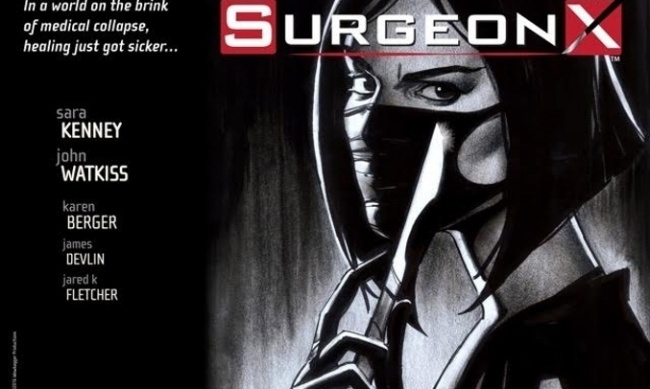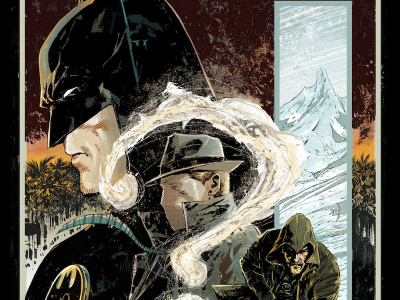So why did six hours of programming that checked all the boxes of “what a modern comics publisher should be doing” end up raising more questions than it answered?
Image is everything. Ever since The Walking Dead began its relentless shamble to the top of the cable ratings and the graphic novel sales charts, Image has been on a roll. By the turn of the teens, the company that was originally founded in 1993 by six young refugees from the work-for-hire side of the industry, and that earned its first flush of fame by fueling the 1990s Roid Age of dark, angry, large and well-armed superheroes, had completely transformed its brand into an oasis of originality and experimentalism.
Saga, Sex Criminals, Bitch Planet, East of West, The Manhattan Projects, Southern Bastards, Chew, Invincible, Fatale and so many others bring together established mainstream artists and writers at the peak of their talents, doing the projects they always wanted to do. The company has managed to channel all that creative energy through a professional production and editorial process that by and large delivers titles on time, and gives readers easy on-ramps with a $9.99 price-point for volume one trade collections.
While other publishers in this same space – Dark Horse, BOOM! Studios and IDW, for example – have other irons in the fire in terms of licensed properties, transmedia ambitions, archival publishing operations and so on, Image appears laser-focused on owning the non-superhero mainstream root and branch.
The question is, how valuable is that particular parcel of land? From the looks of Image Expo, we’re all about to find out.
Too much good stuff. Image Expo debuted the publisher’s stable of titles upcoming, more or less, in the rest of 2016. Among the highlights:
- Afar, a young adult sci-fi series written by Leila del Duca (Shutter), with art by Kit Seaton.
- Black Cloud, a surreal noir-style heroic fantasy series which writers Ivan Brandon and Jason Latour described as “Jessica Jones meets Roger Rabbit.”
- The Black Monday Murders, a suspense thriller set in the late 1980s following the Wall Street crash of 1987, by Jonathan Hickman and Tomm Coker.
- The Divided States of Hysteria, a politically-charged meditation on terrorism, democracy and tribalism by Howard Chaykin.
There was also new work announced by Babs Tarr, Brendan Fletcher, Cameron Stewart, Rick Remender, Joe Harris, Ed Brubaker, Steve Niles, Brian Azzarello (re-teamed with 100 Bullets collaborator Eduardo Risso) – a total of 20 new titles in all.
If the range of content being produced within the art and storytelling style of mainstream comics reminds you of the heyday of Vertigo in the 1990s, that’s no accident. In a defining moment of Image Expo 2016, the guiding force behind Vertigo, former DC Editor Karen Berger, made an electrifying surprise appearance to announce her re-emergence into comics with a new image book called Surgeon X, written by Sarah Kenney with art by John Watkiss (see “Karen Berger Returns to Comics”).
It should also be noted that the Image slate represents a far greater diversity of gender and ethnicity, both of the creators and of the protagonists in the book, than is common in the industry. At a moment when DC and Marvel are struggling to gracefully expand their demographics, Image seems to be doing it organically and effortlessly: another signal that they are ready to embrace the future.
Bounty or glut? While the main presentations at Image Expo didn’t show much art beyond the covers, it seems reasonable based on the samples and the reputation of the talent involved that all of these books will have something going for them. Chances are, if you like anything about Image’s approach, you’d be willing to give any of these books a look.
And therein lies the problem.
Image depends on the direct market to reach customers. That’s a blessing and a curse.
Dedicated, quality-conscious comic store staff can point disaffected customers to a couple of strong Image titles per month, and from what I’ve heard, that dynamic (plus Star Wars) has helped mitigate the attrition and frustration of the past year of failed and delayed events from the Big Two. Image has also built up enough of a track record that retailers are willing to take a flier on experimental, unproven titles. This has clearly helped Image build its market share over the past 12-18 months.
Readers vs. fans. While many comic stores have seen an expansion of their customer base in recent years, habitual direct market customers and big spenders remain fans: creatures of habit, and collectors. Image has cultivated readers. Will they open their wallets wide for this many books? Will enough superhero fans divert a little of their monthly budget to the unknown and unproven?
Despite recent developments, comics remains a world of limited shelf-space and dollars to risk on inventory, where digital is a supplemental rather than primary revenue stream and TPB collections follow periodicals to market. As much as retailers and store managers might personally like and support Image, they can’t ignore that reality. They must be attentive to the risk that the booming non-superhero mainstream niche could outgrow its readership.
Kill your babies. It’s great to be pro-creator. It’s great to say yes to so many unusual premises and open the door to so much new and diverse talent. But how well does it serve creators when their dream projects are pushed into a zero-sum retail environment and pitted against one another, Hunger Games-style, for scarce retailer dollars and customer attention?
That’s why I left Image Expo with mixed feelings. Even if it’s done incrementally and accompanied by a promotional push in both the direct market and digital channels, adding this many books to an already strong lineup to serve an audience that may not exist feels iffy to me. None of the titles seems disposable, but surely many won’t survive, and that will suck.
Image is fighting the good fight to expand the market and push the mainstream out of its rut. They are worth rooting for. But in a 2016 that’s started out rocky for the direct market, the best I can say is, may the odds be ever in their favor.
The opinions expressed in this column are solely those of the writer, and do not necessarily reflect the views of the editorial staff of ICv2.com.
Rob Salkowitz (@robsalk) is the author of Comic-Con and the Business of Pop Culture.









